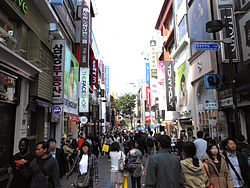Myeong-dong
| Myeongdong | |
|---|---|
| Korean transcription(s) | |
| • Hangul | |
| • Hanja | |
| • Revised Romanization | Myeong-dong |
| • McCune–Reischauer | Myŏng-dong |

Myeongdong, Seoul
|
|
 |
|
| Country | South Korea |
| Area | |
| • Total | 0.99 km2 (0.38 sq mi) |
| Population (2013) | |
| • Total | 3,320 |
| • Density | 3,400/km2 (8,700/sq mi) |
Myeongdong (Hangul: 명동; Hanja: 明洞, literally 'bright cave' or 'bright tunnel) is a dong in Jung-gu, Seoul, South Korea between Chungmu-ro, Eulji-ro, and Namdaemun-ro. It covers 0.99 km² with a population of 3,409 and is mostly a commercial area, being one of Seoul's main shopping and tourism districts. In 2011, 2012 and 2013, Myeong-dong was listed as the ninth most expensive shopping street in the world. The area is known for its two historically significant sites, namely the Myeongdong Cathedral and the Myeongdong Nanta Theatre.
Myeongdong dates back to the Joseon Dynasty when it was called Myeongryebang (Hangul: 명례방; Hanja: 明禮坊) and mostly a residential area. During the Japanese era the name was changed to Myeongchijeong (Hangul: 명치정; Hanja: 明治町, Meijicho in Japanese pronunciation) and became more of a commercial district, being influenced by the rising commerce in the neighboring Chungmuro area. It became the official district of Myeongdong in 1946, after independence.
After the Korean War and into the 1960s, the economy blossomed and the financial sector from Namdaemun-ro and Euljiro gradually expanded into Myeongdong. The area flourished as city renovations took place and highrise buildings were built. Many department stores, shopping centers, restaurants, upscale shops and boutiques set up their businesses in Myeongdong and it became the mecca for the young and trendy in the 1970s.
...
Wikipedia
